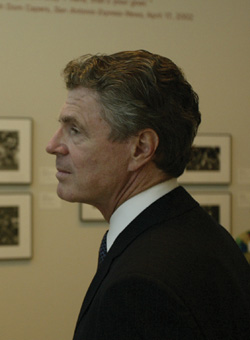
I worked closely with Peter Marzio at the MFAH for close to 18 years. One way to convey the enormous impact of his work is to compare the museum that I first saw in 1984, just one year after Peter had become director, with what was there when I moved away from Houston in 2003.
From a small, regional museum, the MFAH had become one of the best art museums in the United States. The size and range of the collections, the museum campus, and the educational and public programs had grown phenomenally, creating a welcoming, beautiful, and artistically important center for Houston and visitors from around the world. This was due to Peter’s great vision for the institution and the city. Peter believed art had the power to change people’s lives and he communicated this credo to board members and staff alike. He was much loved and will be much missed.
Those are the words of Janet Landay, executive director of the Association of Art Museum Directors and former assistant to Dr. Peter Marzio, who lost his fight with cancer in December of 2010. Janet’s statement echoes those of all who knew Dr. Marzio. To put his accomplishments in the simplest of terms, Dr. Marzio was success personified. During his nearly 30-year tenure as director of the Museum of Fine Arts, Houston, it rose from 30th to the sixth largest in the nation. Marzio doubled the museum in size with the Audrey Jones Beck building, added a sculpture garden designed by Isamu Noguchi as well as a four-and-a-half-acre estate dedicated to European art, more than tripled the permanent collection from 20,000 objects to 62,000, and increased the endowment eighteenfold, via relationships forged with wealthy art lovers like Caroline Wiess Law and Lily Jamail. But perhaps more important than his ability to bring in the bucks was the direction in which he chose to point them. He believed that art was for the people—all of them, and supported exhibits of art from all over the globe, as a way to both educate and include. He knew art had a power, because he was himself changed by it, and wanted to give all people the chance to experience it. As a young student, Marzio was inspired by Goya’s “The Forge” at the Frick Museum in New York. He claimed that the painting had a transforming effect on him, and that, in that moment, he was able to understand the formal elements of the painting. These beliefs are reflected in Marzio’s past, which was as varied as it was rich. He was born on Governor’s Island in New York City in 1943. The first member of his family to finish high school, he earned his bachelors degree at Juniata College in 1965 in Pennsylvania with the help of a football scholarship. Just a year later he got his master’s from the University of Chicago and his doctorate in history three years after that. He lived and studied in Rome on a senior Fulbright research fellowship in 1973. During this time he also taught at the University of Maryland and was research assistant to Daniel Boorstin on his book, The Americans: The Democratic Experience, which won the Pulitzer Prize that same year. After that he served as curator of prints and chairman of the cultural history department at the Smithsonian Institution, where he was editor and an author for their book, A Nation of Nations, in 1976. In 1978, he was named director and CEO of the Corcoran Gallery of Art in Washington, D.C. In 1982 Marzio moved to Houston to head the then fledgling fine arts museum. Though it was inevitable that such an accomplished name as his would appear on the short lists of candidates when vacancies popped up at top museums in other cities, including MOMA in New York City, Marzio was dedicated to what he had started in Houston. He once said that while Houston is by contrast conservative, it is a city of individualists, and that those individualists are both thought-filled and tolerant. That type of community was the perfect breeding ground for a world-class art museum, which is what Marzio created. The next in line of the many highprofile international exhibitions that he arranged is the French Impressionist and Post-Impressionist Masterpieces from the National Gallery of Art, which opens February 20th.













